| Reviews & Columns |
|
Reviews DVD TV on DVD Blu-ray 4K UHD International DVDs In Theaters Reviews by Studio Video Games Features Collector Series DVDs Easter Egg Database Interviews DVD Talk Radio Feature Articles Columns Anime Talk DVD Savant Horror DVDs The M.O.D. Squad Art House HD Talk Silent DVD
|
DVD Talk Forum |
|
|
| Resources |
|
DVD Price Search Customer Service #'s RCE Info Links |
|
Columns
|
|
|
Toshiba HD-A1 HD DVD Player (HD DVD)
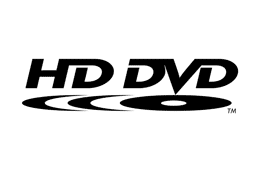
I'll start with a confession: Back in the early 1990s I was a huge Laserdisc fan and collector, and when the DVD format was introduced in 1997 I approached it with great skepticism. Although the little discs technically offered superior features and specs, early software releases were glitchy and suffered from serious digital compression problems, and the first players had a host of their own problems. I wasn't terribly impressed. DVD seemed like, at best, a temporary stopgap between the already high quality LD format and true High Definition, which has always been the real holy grail for home theater fans. Of course, time proved me wrong, and DVD soon revolutionized the way we watch movies. DVD discs and player quality improved in leaps and bounds, far surpassing what was previously possible, and the format's low price and convenience of use made it easy for almost anyone to become a movie buff and home theater aficionado.
I may not have believed it at first, but soon enough I embraced and fell in love with DVD, just as everyone else did, and I've certainly never regretted it. Nonetheless, even throughout these last eight years, the end goal has always been real High Definition. DVD is great, but it's still restricted by the limitations of the antiquated NTSC and PAL video systems. HD is the dream we aspire to. Unfortunately, aside from a limited selection of movies on broadcast TV (usually presented cropped, or censored, or with commercial interruption) and the doomed-from-the-start D-VHS format (did anyone ever really expect an overpriced tape-based delivery system to succeed?), there hasn't been a whole lot of good content to watch in HD. High Definition on a disc, with all of the features and convenience of regular DVD matched with the much better picture quality of HDTV is what we want. And it's taken a damn long time to get here.
Now, finally, here it is. After innumerable delays and corporate infighting, in 2006 we get not one but two High Definition video disc formats: HD DVD from one set of companies and Blu-Ray from another. Out of the gate first, Toshiba has premiered their first two HD DVD players: the HD-A1 (MSRP $499) and the HD-XA1 (MSRP $799). It was worth the wait.
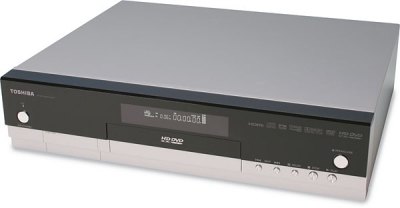
An NTSC DVD is limited to a mere 720x480 pixels of resolution. Combined with Dolby Digital or DTS surround sound, the movie presentation possible from a DVD can be surprisingly, sometimes incredibly, pleasing even on a large home theater display. However, the better your playback equipment and the larger your screen, the more flaws in the format become evident. Home theater equipment is getting more sophisticated and elaborate every day, and there's nothing more disappointing than sitting down to watch your favorite movie on a big screen and finding it marred by compression artifacts, noise, edge ringing, or other digital maladies. Even in a best case scenario with a perfectly mastered disc, when you're able to project a movie onto a six- or eight-foot wide screen in your home, the limited resolution just becomes more and more apparent.
An HD DVD disc stores its movie content at a resolution of 1920x1080 pixels. That's six times the amount of data possible with DVD. The higher resolution is capable of providing an incredibly detailed and vibrant picture. Subtle textures in the image such as the pores on the actors' skin or the fabric weave of their clothes that were never visible on DVD can suddenly jump off the screen. Images retain their stability and sharpness even on very large displays. It's truly a revelation. In order to fit this much data onto a disc the same size as a DVD, players use a narrow-bandwidth blue laser capable of reading much smaller pits and lands on the disc surface, and the video signal is mastered using new and more efficient MPEG4 and VC-1 digital compression codecs that will squeeze more data into less space with fewer of the old MPEG2 compression artifact flaws.
Sound quality also sees improvement on the new discs. HD DVD offers three brand new audio formats for improved clarity and fidelity in movie soundtracks: Dolby Digital Plus, Dolby TrueHD, and DTS-HD Master Audio. All together, it's a home theater dream come true.
Despite their $300 price difference, you'll find that the two HD DVD player models Toshiba is offering at launch are more similar than not. In fact, they have almost the exact same electronics inside, and should deliver identical picture and sound quality. The more expensive HD-XA1 model offers an RS232 port for additional computer networking applications, but beyond that all of the other differences are cosmetic. The flagship XA1 has more robust build quality (read: it's heavier), a motorized flip-down front panel, and a fancier remote control. Is that really worth an additional $300? That's a personal decision, but I would dare to guess that most buyers will be perfectly happy with the HD-A1, which is the model reviewed here. Since the internal components are all the same, most of the following comments should apply equally to either the HD-A1 or HD-XA1.
Not to sound too condescending, but I must emphasize that the only way to get the best performance out of this HD DVD player is to hook it up to an HDTV-capable display using the proper connections. Plugging that old yellow "Video" cable into a Standard Definition set isn't going to gain you any benefit. You might think this is an obvious observation, but nevertheless a major newspaper review recently called the HD DVD player disappointing and barely better than regular DVD, while in the same article the writer admitted to connecting it with the Composite Video cable that came in the box. As anyone who knows anything at all about home video will tell you, High Definition cannot be transmitted by Composite Video. Even on a regular DVD player, Composite Video is the worst connection type you can use.
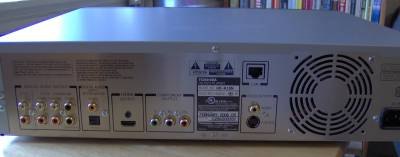
On the HD-A1, High Definition can only be transmitted by analog Component Video or digital HDMI connection. The back of the machine may also contain Composite and S-video outputs, but they are essentially useless and should be disregarded. The HDMI output is compliant with HDCP copy protection and must be connected to another HDCP-enabled device to function. Note that you may also need to turn on the HDMI output using the "V.Output" button on the remote if it isn't set that way by default (mine wasn't).
From a hardware perspective, both Toshiba HD DVD players are fully capable of delivering 720p or 1080i High Definition video over the Component Video analog outputs. However, some discs may be encoded with an Image Constraint Token (ICT) that will automatically reduce the video resolution of the Component Video connections to either 480p or 540p output. As is a mandatory part of the AACS copy protection guidelines, the player must enforce this downconversion if the disc is marked for it. This is a decision that will be made on a disc-by-disc basis and is entirely up to the home video studio releasing the content. Toshiba themselves have no stake in forcing a resolution reduction, but if the studio flags the disc in this way, true High Definition video will only be available via the HDMI connection. At present, none of the HD DVD software titles at launch are marked with ICT, and all will play in true HD over Component Video. Unfortunately, it's not clear which studios will support full HD output over analog Component in the future and which will force a lower resolution at some point. It's also not clear whether the discs themselves will be labeled to indicate as much.
For audio, the player offers the standard Toslink and coaxial S/PDIF digital outputs found on DVD players, as well as separate 2-channel and 5.1 analog connections. The HDMI connection is also capable of transmitting audio along with video. I'll go into more detail on these audio options later.
I'm aware that many potential buyers are worried about how well the HD-A1 will play their existing DVD collections. After all, regardless of how successful or unsuccessful these new High Definition formats become, standard DVD will still be around for a long time. On a personal level, though, I've never fully understood these concerns. If you have a DVD player that you like now, what does it matter how the HD DVD deck plays the same discs? I use the HD DVD player to play HD DVD discs, and a DVD player to play DVD discs. I also use my videogame consoles exclusively for videogames, and never for movie playback. I realize that not everyone has the space or interest to hang onto multiple electronic devices, and many prefer to consolidate their hardware into as few items as possible, but in my opinion the all-in-one design mentality has more compromises than benefits, and I find that you can almost always get better quality by sticking with dedicated components for specific functions.
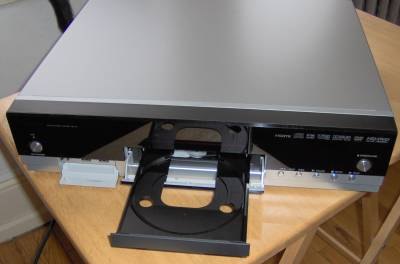
That said, I put the HD-A1 through its paces with regular DVD playback anyway. The unit is compatible with Region 1 NTSC DVDs. It is not a region-free deck and cannot play PAL discs regardless of region coding. The HD-A1 will play DVDs at their original 480i resolution via any of the analog connections, or deinterlaced to 480p over Component video. It will not upscale copy-protected DVDs to higher resolutions over Component. Via HDMI, DVDs can be output at 480p (but not 480i) or upscaled to 720p or 1080i. The machine will read the aspect ratio flag on each DVD disc and it automatically pillarboxes 4:3 and non-anamorphic content into the center of the 16:9 frame whether you want it to or not. It does not offer any options for zooming non-anamorphic letterbox content to fill the screen.
I tested anamorphic DVDs upscaled to both 720p and 1080i resolution over HDMI. The quality of the scaling itself is quite good, at least on par with other high performance upconverting DVD players on the market. I didn't notice any unwanted scaling artifacts such as pixelation, softening of the image, color banding, or edge ringing. On the downside, the deinterlacing quality is not as good. The unit failed many of the complex tests on the HQV Benchmark DVD, including diagonal line filtering and mixed-source cadences. The scrolling text test came out especially poor. Oddly, the infamous waving flag and racetrack tests looked better than expected while some of the simpler tests that even lesser players pass looked worse. Depending on what type of content you watch, this will be of more concern to some viewers than others (standard film-based movies seemed mostly fine), but is certainly not up to the same standard as the Faroudja, Silicon Image, or HQV deinterlacing found in the best DVD players.
Let's get down to the heart of the matter: Does HD DVD live up to the hype? Yes, absolutely it does. The High Definition picture quality on the discs available so far looks terrific. Really, really terrific. The detail, texture, and depth of images are all fantastic, much better than even the best DVDs. It compares favorably the very best High Definition content available by broadcast, and is certainly much better than the worst HD I've seen on cable. What's more, things will only get even better over time. DVD mastering has come a long way since those first releases in 1997, and I expect the same for HD DVD. If these first titles are some day considered at the low end of HD DVD quality, the future looks bright indeed.
Having said that, I must add one important caveat. The HD-A1 must be set for 1080i output regardless of the resolution of the display it's connected to. Although it may sound counter-intuitive, owners of 720p HDTVs should not set the HD-A1 for 720p output. Unfortunately, even though the unit's upscaling of DVD content to 720p looks pretty nice, it's downconversion of the 1080p data on an HD DVD disc to 720p resolution is quite poor. At that setting, the image is significantly softened and many artifacts are introduced. You're much better off leaving the output at 1080i and allowing the display to do the conversion. This is certainly disappointing, but in light of the excellent 1080i output, is not a serious drawback.
Technically, the player's manual advises to change the resolution output to match that of the disc content. I suppose this means that should some studio elect to encode movies or TV shows on HD DVD at 720p resolution, the player may do better set for 720p output in that case. Until such discs are actually available, this is just speculation.
As mentioned earlier, the movie content on HD DVD is stored on disc in 1080p progressive format. Yet the player only offers 720p or 1080i HD output options. Raw 1080p output is not available on either the HD-A1 or HD-XA1 models. With a small number of 1080p resolution HDTV displays trickling to market, this issue has been used as a point of contention from backers of the rival Blu-Ray format, some players from which will supposedly offer the option of 1080p. However, the issue has been largely overblown beyond its actual relevance. For one thing, the vast majority of HDTV displays in homes and currently on the market are limited to 720p or 1080i resolutions. Further, even among those small number of 1080p displays, fewer still will actually accept a 1080p input signal. Most are limited to accepting a 1080i signal and deinterlacing it internally.
Even if we accept the presumption that over time 1080p displays will gain more market share, the fact is that the 1080i output from an HD DVD player provides every piece of necessary data for the display to reconstruct the original progressive frames seamlessly. The most concise and informative summary of the 1080i vs. 1080p argument that I've yet read is available from the Projector Central web site, a portion of which I'll excerpt here with permission:
In the last couple of days, several technical issues have been put to rest, at least for me. The first was the common accusation that the initial HD DVD players like the Toshiba HD-A1 are deficient because they don't output "full 1080p" resolution, that they are "1080i only." I don't see this as a practical concern. All HD DVD and Blu-ray discs will encode film-sourced material in full 1920x1080 progressive scan resolution at 24 frames per second, which is the film industry standard.For those still not convinced, it's very likely that Toshiba will provide 1080p output on future models. This 1080i limitation is one of the premiere players, not of the HD DVD format as a whole.Unfortunately many folks are confusing 1080i acquisition with 1080i transmission. The primary reason we get interlacing artifacts in a 480i, 576i, or 1080i signal is that the frame was originally captured in interlaced format, with the odd scan lines and even scan lines being recorded at two different moments in time. When you reassemble two fields that are offset in time, you get jaggies, moire patterns, barber pole effects, and line twitter. That is not true of either HD DVD or Blu-ray film transfers since the image is scanned progressively from a film frame that represents a single moment in time.
Therefore we would expect to see none of the common evidence of deinterlacing when watching HD DVD or Blu-ray movies that are being transmitted via 1080i. Our first look at HD DVD in 1080i confirms this expectation. After hours of viewing three different HD DVD movies there is simply no evidence of any artifact that might be attributed to the fact that the signal was transmitted in 1080i format. The picture is as clean, stable, and as artifact-free as it could be. There is no visible defect in the image that would be eliminated by switching to 1080p transmission.
Perhaps the most confusing aspect of the HD DVD launch concerns the new high-resolution audio formats and how the players handle them. HD DVD introduces three new audio formats, all of which require more bandwidth (and copy protection) than can be transmitted via traditional Toslink or coaxial S/PDIF connections. In order to accommodate backwards compatibility with existing surround sound receivers, the HD-A1 and HD-XA1 players employ some unexpected delivery methods.
Dolby Digital Plus is essentially an enhanced version of normal Dolby Digital surround sound that's encoded at higher bit rates and is capable of up to 7.1 discrete channels. The HD-A1 and HD-XA1 utilize an internal DD+ decoder that converts the signal to discrete multi-channel PCM which can then be output one of three ways:
- The HDMI output may be connected to an A/V receiver with compatible HDMI 1.1 or better input. This will then transmit the discrete PCM channels for subsequent decoding and amplification. This is the most ideal connection method.
- The PCM channels can be decoded to analog and output over the player's 5.1 analog connections directly to a receiver with 6-channel analog inputs. This is the next best connection method. Obviously, movie soundtracks encoded in 6.1 or 7.1 format would need to be downmixed to 5.1 channels using this option. I can hope that subsequent players from Toshiba or other manufacturers will offer 7.1 analog outputs.
- The final method is the most unusual. The player will indeed allow the movie soundtrack to be transmitted over Toslink or coaxial S/PDIF cables, but in order to accommodate this the multi-channel PCM is re-encoded as a full bit-rate 1509 kb/s DTS signal. Thus, even though the disc has a Dolby soundtrack, it's accepted at the receiver as DTS (I have to wonder how the Dolby people feel about that). DTS was chosen for this application because it allows for higher bit rate transmission than standard Dolby Digital. The resulting audio is technically a downconversion that sacrifices some of the potential clarity and fidelity of the original DD+ soundtrack, but should sound every bit as good as full bit-rate DTS from a normal DVD does (which, as most people will tell you, is pretty damned good). Unfortunately, the decision to re-encode everything as DTS means that viewers with Dolby-only A/V receivers (who don't also have HDMI or multi-channel analog inputs) are left out in the cold.
[Update: On August 25th, 2006 Toshiba issued a firmware update (version 2.0) for the HD-A1 and HD-XA1 players that upgrades their audio sections to Dolby TrueHD 5.1 capability. The firmware may be downloaded from Toshiba by following the instructions in the manual.]
Finally, DTS-HD Master Audio is the DTS equivalent of Dolby TrueHD, a lossless high-res audio format with 7.1 channels. The HD-A1 and HD-XA1 are technically compatible with DTS-HD, but only to the extent that they will extract the "DTS Core" signal (basically, standard DTS quality as found on DVD) for output. The players aren't able to output the full DTS-HD MA signal at this time. Again, hopefully later players or a future firmware upgrade will offer that feature.
As it stands, the first-generation HD-A1 and HD-XA1 players don't fully implement all of the audio features that the HD DVD format is capable of offering, but at the very least they will provide sound quality equal to or better than the best that the DVD format currently delivers. That's certainly nothing to sneeze at.
This is a first-generation product of a brand new technology. It delivers in the area where it most counts, pure performance quality, but I won't deny that it has some design quirks and annoyances.
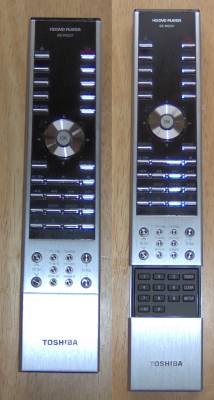 First off, the player takes a long time to boot up and load discs. The internal processor is more like a computer than a normal DVD player (the unit even has a cooling fan on the back), and has to go through a lot of analysis before it's ready to play a disc. It can take upwards of a minute for the player to fully power on after startup, and discs usually require another 30 seconds or so. That's definitely frustrating in comparison to the speed of regular DVD players, but hardly a deal-breaker to my mind.
First off, the player takes a long time to boot up and load discs. The internal processor is more like a computer than a normal DVD player (the unit even has a cooling fan on the back), and has to go through a lot of analysis before it's ready to play a disc. It can take upwards of a minute for the player to fully power on after startup, and discs usually require another 30 seconds or so. That's definitely frustrating in comparison to the speed of regular DVD players, but hardly a deal-breaker to my mind.
The setup menus are difficult to navigate (especially the audio options), and if you ever need to jump to them mid-movie, the player will not remember your last position on the disc. The player also has a habit of losing HDCP sync anytime you start or stop a disc, or go to the setup menus.
You'll notice that the menu structure of HD DVD discs is different than regular DVDs. The format uses a new interactive feature called HDi (formerly iHD) that allows you to bring up disc menus and change setting options while the movie is still playing. That's actually a rather neat idea. Unfortunately, the usual method of changing subtitles or audio by the remote is much clunkier and barely works at all. If you want to make an adjustment on the fly, you'll basically have to use the disc menu whether you want to bring it up on screen or not.
Most irritating, the player comes with what is just about the worst remote control ever designed. The button layout isn't intuitive (some of them are even hidden under a sliding panel), the gray text on black background isn't legible in a darkened room, and the responsiveness of the commands is nothing short of awful. Buttons on the directional pad usually take about 8-10 pushes before anything happens. These problems are all easily solved by programming the commands into a universal remote, but Toshiba should seriously consider redesigning this piece of junk remote and offering a replacement program for buyers.
Are any of these serious complaints? Not at all. They are superficial annoyances at most, and some of them may wind up fixed in future firmware updates (the player can be connected to the internet when feature upgrades are available). You may hear some grumbling from owners, but the unit's performance more than makes up for any of these minor shortcomings.
It's only natural that people may hesitate in their purchase of an HD DVD player with the rival Blu-Ray format just a few months away. Although none of the Blu-Ray manufacturers have supplied hardware for evaluation yet, what we do know so far is that despite some technical differences the two formats are more similar than not. They both provide true High Definition video content and the exact same high-res audio formats on an optical disc similar to DVD in its convenience and usage. HD DVD has the advantage of lower price and getting out the door first, while Blu-Ray will be (at least initially) supported by a wider selection of hardware manufacturers and movie studios. The first Blu-Ray players will, however, cost at least twice as much as the comparable HD DVD player (announced prices range from $1,000 to $1,800).
For the record, we here at DVDTalk plan to give both formats their fair shake. I personally expect that both will offer near-identical picture and sound quality, but if Blu-Ray players and software prove to be worthy of their premium prices you'll read about it right here.
After all the delays, the era of High Definition on disc is finally here. Whichever format, HD DVD or Blu-Ray, eventually wins out over the other (assuming there is a clear winner), movie buffs and home theater fans are in for a treat. Needless to say, the advantages of High Definition over regular DVD are more apparent the larger your screen size, but that doesn't imply that everyone else won't see the difference. Anyone with an HD-capable display that's been properly connected and calibrated should marvel at the improvement.
With an MSRP of $499, the Toshiba HD-A1 offers the high quality expected of it at a surprisingly affordable price for new technology. Yes, the player still has some kinks to be worked out as far as its convenience features go, but none of them are true deal-breakers and the unit certainly delivers the terrific picture and sound that matter; some of the initial problems may even be alleviated by future firmware updates from the manufacturer. The player's strengths vastly outweigh is weaknesses. Home theater enthusiasts are known for spending great sums of money to eek out every last bit of marginal improvement to their video signal. Here we have a major upgrade that can be gotten for a reasonable price. It's worth the investment. The High-Def revolution has finally begun, and it's off to a very good start.
Related Articles:
HD Review Index
Samsung BD-P1000 Blu-ray Player
The Last Samurai (HD DVD)
Million Dollar Baby (HD DVD)
The Phantom of the Opera (HD DVD)
Serenity (HD DVD)
Swordfish (HD DVD)
Toshiba HD DVD Product Introduction Event
Oppo OPDV971H DVD Player Review
Neuneo HVD2085 DVD Player Review
|
| Popular Reviews |
| Sponsored Links |
|
|
| Sponsored Links |
|
|
| Release List | Reviews | Shop | Newsletter | Forum | DVD Giveaways | Blu-Ray | Advertise |
|
Copyright 2024 DVDTalk.com All Rights Reserved. Legal Info, Privacy Policy, Terms of Use,
Manage Preferences,
Your Privacy Choices | |||||||










